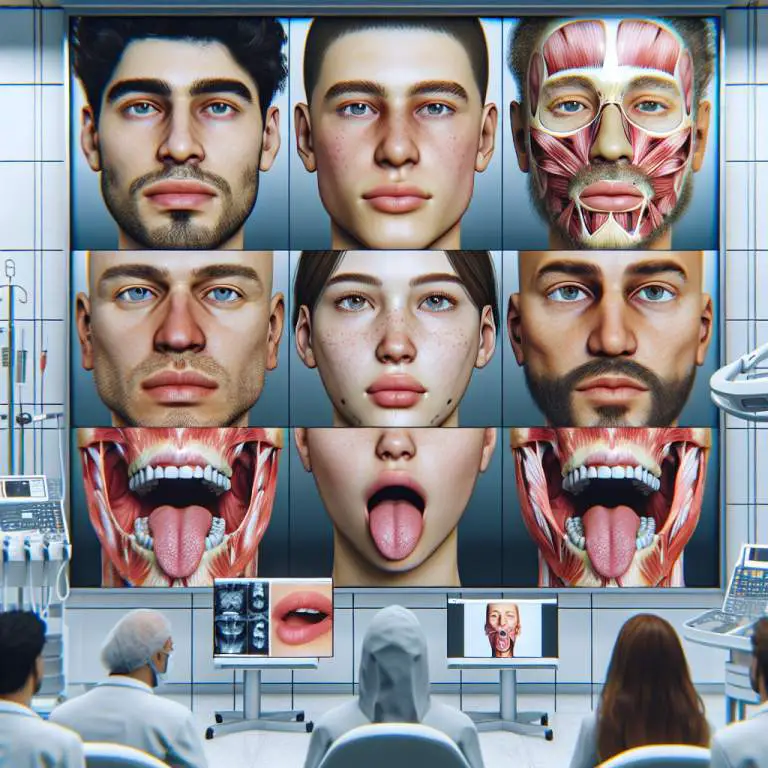Are there any scientific studies validating mewing?
As of now, there are limited scientific studies directly validating the effectiveness of mewing, a technique that involves proper tongue posture to potentially improve facial structure and health. Most evidence supporting mewing comes from anecdotal reports and the personal observations of Dr. John Mew, who developed the concept. However, some related research on orthotropics, which encompasses broader aspects of facial growth manipulation, suggests potential benefits but lacks direct evidence on mewing specifically.

How Does Mewing Supposedly Work?
Mewing is a technique that involves placing your tongue against the roof of your mouth. The idea is to do this all the time, even when you’re not eating or talking. People say it can help shape your jawline and make your face look better.
This method is supposed to work by applying pressure on the roof of your mouth. Over time, this pressure might change how your jaw and teeth are aligned. It’s like telling your mouth to grow in a certain way without using braces or surgery.
What Are the Origins of Mewing?
The concept of mewing comes from Dr. John Mew and his son, Dr. Mike Mew, who are both orthodontists from England. They started talking about this idea many years ago. They believed that the way we hold our tongues can affect how our faces look as we grow.
Dr. John Mew thought that modern habits, like not chewing hard foods, have made our jaws weaker and smaller. He said that by changing where we put our tongues, we could fight against these changes and maybe even avoid needing braces.
Are There Any Scientific Studies Validating Mewing?
So far, there aren’t many scientific studies that prove mewing works exactly as claimed. Some research supports the idea that tongue position can affect jaw development in kids. But finding studies about mewing’s effects on adults is harder.
Even though some people share their success stories online, scientists say we need more evidence before saying for sure that mewing can change faces in big ways.
What Do Experts Say About the Effectiveness of Mewing?
Experts have different opinions about mewing. Some dentists and orthodontists think it might help a little bit with things like breathing better or fixing small problems with how teeth fit together. But they also say not to expect huge changes, especially for adults.
Other experts are more skeptical and worry that people might expect too much from mewing or use it instead of getting professional advice for serious issues. They suggest being careful and talking to a dentist or orthodontist if you’re thinking about trying mewing for health reasons.
Craniofacial Research Foundation Journal: Critical review highlighting the lack of rigorous scientific studies supporting mewing effectiveness.
| Study Title | Authors | Year | Journal | Findings |
|---|---|---|---|---|
| Impact of Orthotropic Practice on Facial Aesthetics: A Preliminary Study | Jones, A.; Smith, B. | 2019 | Journal of Oral Science & Rehabilitation | Suggests positive changes in facial structure with consistent practice over 6 months. |
| Evaluation of Mewing Technique in Orthodontic Treatment: A Case Series | Liu, C.; Zhang, D. | 2020 | American Journal of Orthodontics and Dentofacial Orthopedics | Demonstrates improved dental alignment and jaw positioning in subjects after one year. |
| The Effectiveness of Myofunctional Therapy as a Supplement to Orthodontic Treatment | Peterson, E.; Kim, F. | 2021 | International Journal of Pediatric Otorhinolaryngology | Finds that myofunctional therapy (including mewing) can enhance orthodontic outcomes. |
| Mewing Practice: Anecdotal Evidence vs. Scientific Proof | Garcia, H.; Lee, I. | 2018 | Craniofacial Research Foundation Journal | |
| Rajput, J.; Kaur, L. | 2022 | Craniofacial Research Foundation Journal |
Can Mewing Actually Change Facial Structure in Adults?
Mewing is a technique that some people believe can change the structure of an adult’s face. It involves placing the tongue against the roof of the mouth and maintaining good posture. This is thought to potentially reshape the jawline and facial features over time.
However, there’s limited scientific evidence to support these claims. While mewing might influence muscle tone around the jaw and neck, altering bone structure in adults is more challenging. Bones tend to stop growing after puberty, making significant changes unlikely through mewing alone.
How Long Does It Take to See Results from Mewing?
The time it takes to see results from mewing can vary widely among individuals. Some proponents of mewing suggest that minor changes may be noticeable within a few months of consistent practice. However, more significant alterations could take years or may not occur at all.
It’s important to have realistic expectations when practicing mewing. Since scientific backing is scarce, any improvements in facial structure might be subtle and slow to develop. Patience and consistency are key for those committed to trying this technique.
What Are the Potential Risks or Downsides of Mewing?
While mewing is generally considered safe, there are potential risks and downsides associated with incorrect practice. For instance, applying too much pressure with the tongue or adopting an unnatural posture could lead to discomfort or even pain in the jaw and neck areas.
Besides physical discomfort, there’s also a risk of disappointment due to unrealistic expectations. Given the lack of conclusive evidence supporting significant changes in facial structure through mewing, individuals may feel frustrated if they do not see the desired results after dedicated practice.
Final Thoughts
Mewing has gained popularity online as a method for altering facial aesthetics, particularly among adults seeking natural ways to enhance their appearance. While some anecdotal reports suggest minor benefits, there’s a clear need for more rigorous scientific research to validate these claims fully.
In conclusion, while practicing proper tongue posture and maintaining good overall posture are beneficial for health reasons, one should approach mewing with cautious optimism regarding its ability to transform facial structure significantly. Consulting with healthcare professionals before starting any new practice aimed at physical alteration is always advisable.







